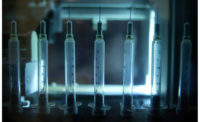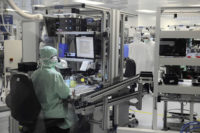The latest generation of pressure-sensitive adhesives and converted materials offer great potential for product improvement. They hold the key to better product performance, greater manufacturing efficiencies, better staff utilization, and ultimately across-the-board cost reduction.
Examples of manufacturing success attributable to better material uses span all industries and applications. An appliance manufacturer employs a low-tack film to protect the finish on washers and dryers. An automotive manufacturer uses a pressure-sensitive adhesive to attach very long trim parts. A fastener company sped up assembly with adhesive-backed rubber washers. A defense contractor uses a pressure-sensitive adhesive to bond thermal insulation panels to the engine compartments of military vehicles. An electronics firm improved worker safety and increased productivity with die-cut tape.
The common denominator in these and many other examples is a more intelligent use of materials to enhance, speed up, and simplify manufacturing.
Getting Protective
How do you keep new washers and dryers in pristine condition during the distribution cycle, with multiple sales personnel and customers pushing and prodding every dial on the control panel? The answer is to apply removable, low-tack adhesive sheets that are die-cut to fit the control panel. The sheets remain on the machines until the product is delivered to the consumer. Then they are removed easily and cleanly without leaving adhesive residue.
The challenge for Fabrico and the appliance manufacturer was to design the die-cut materials so:
- they could be easily handled and applied by assembly personnel.
- they could be produced in an automated, high-volume process that was cost-effective and made the most efficient use of material.
Working with our colleagues at Light Fabrications in Rochester, NY, we tested several adhesive materials from multiple vendors. In the end, we recommended a light protective film in roll form. Circles were perforated within the overall die-cut shape for easy application over machine knobs. The adhesive sheet can be unrolled over the machine console and gently pressed into position while releasing the perforated portions in one easy motion. Parts are produced on a high-speed die-cutting system, which guarantees repeatable cuts and perforations while dramatically reducing cost.
Making Short Work of Long Trim
Manufacturing 40-inch automotive body side molding is only half the problem. You also have to apply it. Therefore, converting acrylic foam tape for this application had both product and process implications. This was solved by manufacturing the long parts with a sophisticated release liner that assists in positioning the part. At the same time, the liner keeps the parts from bonding to each other.
The part and the liner are manufactured together in one seamless die-cutting step. Parts are produced with an extended base liner and a specially designed “looper” tab that is carried on an added liner to facilitate removal. A proprietary packaging method was incorporated into the die-cutting process, which separates the parts as they are placed into a long shipping box. This allows operators to easily remove the parts from the box and to quickly and accurately apply the converted acrylic foam tape to the side molding prior to application to the automobile.
From Sheet to Roll
It was no surprise that an automotive manufacturer putting down 1 million adhesive-backed washers needed to upgrade from a manual sheet-fed operation to high-speed roll dispensing. But the washer manufacturer couldn’t produce the parts in roll form. So Fabrico and Light Fabrications were brought in to solve the format problem, while making the washer more effective in the process.
Originally, the die-cut Poron washer had adhesive applied to one side. This was replaced with a lamination of Poron and a double-sided adhesive on 3-mil PET film, die-cut to the finished washer spec. The 3-mil film allows the rolls of die-cut parts to be fed from a standard label dispenser. Changing both the adhesive and the format is estimated to have produced an overall productivity increase of 20 percent to 30 percent for the manufacturer.
And, the manufacturer could get an even bigger improvement in productivity. The redesigned washer is compatible with robotic assembly systems.
Curtain Up on Engine Heat
A defense contractor needed to apply a thermal curtain inside the engine compartment of a military vehicle. Initially, the manufacturer tried replacing metal fasteners with a liquid adhesive. However, the adhesive was messy to apply, and it was not 100 percent successful in holding the curtain in place.
The solution was to laminate a thermal fabric with two single-sided tape lanes, one on either side of the fabric. The tape lanes contain a high-temperature pressure-sensitive adhesive (good to 450 C). A release liner protects the adhesive
during handling. The high-strength adhesive was formulated to bond to both thermal fabric and cast aluminum. The adhesive, evenly applied through a laminating process, is easy to make and apply to the vehicle, saving time and money at each step of the process.
VHB Turns the Lights On
A manufacturer of large illuminated signs was using hand-cut tape pads to attach electronic components. The tape, VHB from 3M, was chosen for it resistance to ultraviolet radiation, hot and cold temperatures, and the elements. However, with the hand-cut approach, labor cost was a huge issue, as was employee safety. Workers literally made thousands of cuts a day. So the company looked for a safer, more automated solution.
Today, the pads are die-cut from 4-inch wide rolls of two-sided VHB tape (four pads across). One liner is left longer on one side to serve as a lift tab. The operator simply pulls the pad from the roll, applies it to the component, and then lifts the tab out of the way prior to assembly.
Die-cutting the tape dramatically lowered labor costs and increased productivity. Die-cutting the tape also ensures greater consistency in the dimensions of the VHB pad, enhancing product quality. The tab design has been so successful that that company now uses it in other assembly operations.
The Trick Behind the Mask
A major manufacturer produces 500 engines per day. In its painting process, the company used a large round mask to protect machined areas. However, the mask was difficult to apply, which drove up assembly time and cost. Each mask cost $2 and was thrown away after use. All totaled, the mask cost $1,000 per day, or close to $250,000 per year.
Fabrico and Light Fabrications solved the problem with polycarbonate and foam. We created a mask of 3/16-inch polycarbonate that fits tightly to the engine via an inner ring of high-temperature silicone foam. The materials can withstand the 200 F drying oven for 30 minutes per cycle. The mask and ring also allow for paint removal after each part is finished, enabling reuse of up to 50 times. This saves the manufacturer substantial cost. In addition, because the mask and ring can be put in place in 30 seconds, setup between engines is dramatically improved.
Tiny Gaskets Get Laser Treatment
A medical device manufacturer had to apply a small gasket to one of its latest products. Smaller than a penny and made from soft foam, the gasket had an intricate design. Intricate or not, the gasket had to stay put when applied. Careful treatment was required.
In this kind of an application, die-cutting has two limitations: It distorts the edges of the material, and it has difficulty accomplishing intricate designs.
Instead of die cutting, Fabrico and Light Fabrications advised the manufacturer to laser-cut the gasket from single-sided polyurethane foam tape. Laser cutting protects the soft foam from edge distortion. The technology is more than capable of creating intricate designs through two dissimilar materials (foam and adhesive liner), and it can do so with repeatability and high throughput. In this case, the manufacturer received a better product, a more efficient manufacturing process, and a significantly lower reject rate.





